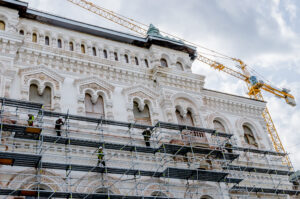
How is historic preservation beneficial?
Historic preservation, the conservation, and restoration of buildings, objects, and sites vital to history are integral to recognizing and celebrating our pasts. Without learning the stories behind them, we wouldn’t be able to understand where we came from. Besides connecting with the past, historic preservation is beneficial in many ways. How so?
Historic Buildings Add Value to Communities
Buildings that have a long-standing piece of a community physically represent local culture and history. These powerful symbols instill a sense of pride and cultural identity in residents who view and occupy them. Thus, connecting them to their community’s more significant place in history and the world.
Additionally, historical buildings are beneficial because they provide more education opportunities, lending real meaning to the events and individuals we learn about in school. Moreover, older structures have aesthetic value, diffusing their neighborhoods with unique character.
Preservation Assists the Local Economy
Furthermore, the process of preserving historic buildings can be extensive. While it might seem daunting to pay for the work to be done, all of that money goes back into helping the local economy. This includes producing more jobs and a profitable structure in the long run. Historic preservation is also an effort that requires the work of several industries, such as landscaping, construction, project management, and more.
Fortunately, opportunities open up new businesses and heritage tourism to join and stimulate the local community once a historic building restoration is complete. In fact, owners of non-chain companies often seek older buildings so their brands can thrive from the authentic atmosphere they create.
Many Older Buildings Were Built with Better Quality Materials
Besides monetary worth, there’s an inherent value to historic buildings. Older properties are frequently or even more valuable than newer ones due to age. Sometimes, they are built with a more cohesive and appealing design, finer architectural details, and rare hardwoods and other materials that are more expensive to construct today because they are not in use anymore or not widely available.
Historic preservation is beneficial because historic buildings often are sturdier than newer properties. This is due to the use of these higher-quality materials. They also prevalently feature a more energy-efficient design, with architecture that takes better advantage of cross ventilation and natural light.
Historic Buildings are Good for the Environment
Building new structures for companies, housing, etc., in a community requires using new construction materials and land for development. When historic buildings are in restoration, residents still receive the opportunity for innovative progress while preserving natural resources. Check out our recent blog regarding converting a once-segregated aging West Baltimore elementary school into Justice Thurgood Marshall Amenity Center!
Contact Us Today!
Whenever you’re ready to build or renovate a business, Mahogany Inc. has your back. Call us at 410-727-0334 with any questions and speak to one of our licensed professionals. To see examples of our work or to gain inspiration for your next project, follow us on Facebook, Twitter, and Pinterest.
